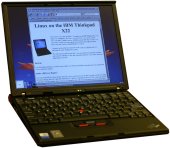

|
A new IBM Thinkpad, so time to install Linux. This time Suse 9.1. As always, the Linux on Laptops page has been very useful. Warning It is very easy to destroy data while installing any operating system, so make sure you have backed up anything you want to save. |
This came with Windows XP Pro installed. As is popular these days, there were no reinstall/rescue discs included, but instead a small hidden partition on the disk contains a Restore and Rescue utility. Press the blue "Access IBM" or F11 on boot to start this. F1 will take you to the BIOS.
Note On the first boot of Windows it converts the FAT32 partition it lives on into a NTFS filesystem. If that worries you and you want to be able to mount the Windows partition from Linux you need to stop this happening. Until Linux support mountable NTFS you can use the ntfs tools to read the partition, but not write to it.
To prevent the conversion, you can move the program C:windows\system32\autoconv.exe to, say, noautoconv.exe. This you can do by booting off a rescue disk (e.g., choose rescue from the Suse boot CD) and doing it from there.
If you mess up the Windows partition it is easy (but time consuming) to reinstall Windows from the Restore and Rescue. Note: when you shrink the Windows partition, make a new partition in the gap, or else the Rescue utility will expand the Windows partition right back out again.
I didn't want to keep Windows, so I overwrote it in the partitioning phase, below.
Suspend (to memory) works, but see USB below.
As for standby (hibernate to disk), I made a filesystem (mkdosfs -F 16) on the hibernate partition, mounted it (mount -t vfat) and used tphdisk to make a save2dsk.bin file. The file size required is RAM + Video memory + 2M. Note that video RAM on the X40 is DVMT (shared with main system memory).
After a reboot, hibernate using Fn-F12 works, but is quite slow. It takes over a minute to save 760MB of memory and a similar time to restore. By comparison swsusp is a bit faster to save, but only just faster to restore.
Section "InputDevice" Driver "mouse" ... Option "ZAxisMapping" "4 5" EndSectionIt is possible to enable DRI acceleration by putting the line Load "dri" in Section "Module" of /etc/X11/XF86Config. This increases glxgears from 240fps to 1250fps. The downside is that this is incompatible (in kernel 2.6.5) with suspend/restore: the screen comes back in a very weird state. The culprit is the i830 module, which appears to be unloadable without a reboot.
The default BIOS settings try to save power by turning everything off when your back is turned. I prefer to keep things running. In Config -> Power:
The hostname is set to linux.site. Fix in /etc/HOSTNAME or somewhere in the Yast2 system.
Suse does not load several essential packages by default: gcc, make, emacs, pine, and so on. Fortunately, installing them with yast2 is trivial. Always run update after installing a package to check for updates.
Suse has an interesting "scheme" mechanism scpm that allows you to switch between configurations as you move about. It's a little slow, but very thorough.
The keypad volume controls, mute, Fn-F4 for suspend, Fn-F12 for standby, Fn-Home and Fn-End for screen brightness and the light (Fn-PgUp) all work.
Suse employs resmgr to allow users access to various bits of hardware, such as the CD drive. This is configured via /etc/resmgr.conf and the default is to have a desktop class that is allowed use CDs, scanners and the like. The default way to join this class is to log in via XDM wherupon PAM magic grants you these rights. If you chose not to use XDM, you don't get to use the CD. A quick fix is to add the line
session optional pam_resmgr.so grant=desktopto /etc/pam.d/login. This grants desktop privileges (i.e., CD use) to anyone who logs in using login. Do resgmr list to see what devices you can use. I also added
add /dev/sg0 desktopto /etc/resmgr.conf to get grip to work.
Russell Bradford, September 2004.